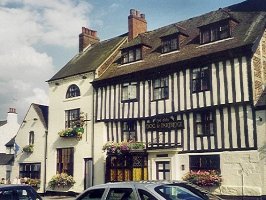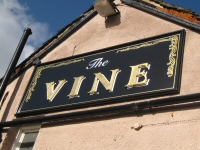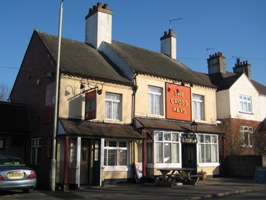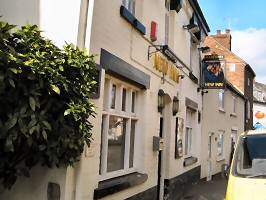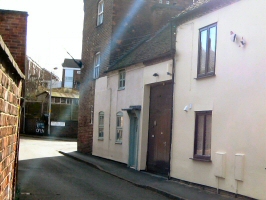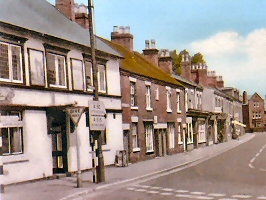Tutbury Pub Names
Inns, Taverns & Pubs
In the early Middle Ages, travellers usually found accommodation in monasteries, but later, because of the Crusades and the popularity of pilgrimages, lodging houses (inns) were built by monasteries, guilds, and private entrepreneurs. By the late 16th century there were about 6,000 inns. The English inns of the Middle Ages were sanctuaries of wayfaring strangers, cutthroats, thieves, and political malcontents.
The tavern, the predecessor of the modern restaurant, originated the custom of providing a daily meal at a fixed time, where alcoholic beverages are sold for consumption on the premises. By the middle of the 16th century the dining-out habit was well established and most taverns offered a good dinner for less than a shilling, with wine and ales as extras. Tobacco was also sold after its introduction into England in 1565. Taverns also offered companionship and some of the better ones became regular meeting places.
Early on, English law imposed social responsibilities for the well-being of travellers upon the inns and taverns, declaring them to be public houses which must receive all travellers in reasonable condition who were willing to pay the price for food, drink, and lodging.
In Tudor England, selected innkeepers were required by a royal act to maintain stables and some acted as unofficial postmasters and kept stables for the royal post. In the mid-1600s, some public houses even issued unofficial coins which the innkeepers guaranteed to redeem in the realm's currency. By the 1800s, many of these establishments were divided internally to segregate the various classes of customers. Public houses were considered socially superior to alehouses, beerhouses, and ginshops.
The early inns or taverns were identified by simple signs, such as lions, dolphins, or black swans. Many colourful pub names (e.g., Bag o'Nails, Goat and Compass, and Elephant and Castle) are actually corrupted phrases and titles (e.g. "Bacchanals," "Great God Encompassing," and "Infanta de Castile").
In the 18th century, the word Arms was added to many pub names, indicating that the establishment was under the protection of a particular noble family, although some heraldic signs were references to the original ownership of the land on which the building stood. Although public houses were traditionally owned and operated by licensed publicans, by the early part of the 20th century many of them were owned or connected to a small number of brewery companies.
There used to be 17 inns in Tutbury but now there are just 5: |
||
|---|---|---|
Dog and Partridge - High St
|
Built in the 14th century, in the days of John of Gaunt. It was a rich man’s house - probably the Steward of the Castle. The name was associated with hunting in the forest. Most current buildings are 16th & 17th century with additions in the 18th century for coaches: The Red Rover ran from Liverpool to London at 4am and returned at
8pm. |
|
The Vine, Ludgate St
|
There was a vineyard near the castle in 1374. |
|
Cross Keys, Burton St
|
Near to a footpath to the mill - the Baulk. The sign bears a very old sign - the Papal coat-of-arms, being the
emblem of St. Peter |
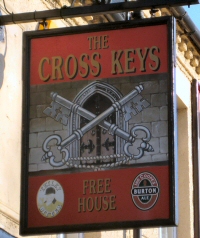 |
Leopard – Monk St
|
The black leopard was on the coat of arms of the Mosley family who lived in Rolleston |
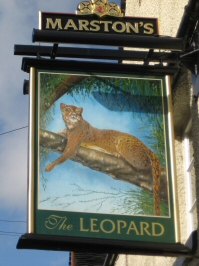 |
New Inn - Ludgate St |
Fairly modern and still licenced
|
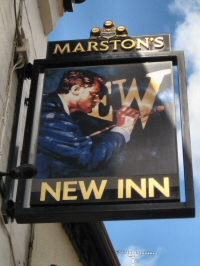 |
The following are no more: |
||
The Old Cock - Lower High St formally Cheapside |
The Cock was supposed to be an illustration of St. Peter. Or the name may be a result of cock fighting. Closed |
|
Queen’s Head – High St |
The sign probably carried a portrait of Elizabeth l, who was the Duke of Lancaster and Lady of the manor. In 1851, Thomas Mayer was also the carrier between Burton, Tutbury, Uttoxeter and Derby. Stabling was at the rear of the property Closed |
|
Rose & Crown – Burton St |
The name was directly connected to the House of Tudor Closed in 1910 |
|
Shoulder of Mutton – High St |
A fairly prosperous inn in the 1850s with part of the premises being a cooper's shop. Originally used for accommodation by the Priory and for a monthly Court Closed and now a chemist shop and adjoining house. |
|
Woolpack – Duck St
|
The woolpack was a train of pack-horses tied head to tail with sheeted bales of wool slung over the wooden pack saddle. They would stop here for the night, mainly from Lancashire. Can still be seen as a large pair of double doors in Silk Mill Lane - formally Duck St Once the home of Tutbury's first bus station. Delicenced in 1916. Now a private dwelling. |
|
Farriers Arms – High St |
Probably a branch of the old Guild of Blacksmith’s Closed |
|
Joiners Arms – Cornmill Lane |
Now a private dwelling |
|
Wheel – High St |
Believed to have been a corruption of the Catherine
Wheel, the badge of the Knights of St. Catherine of Mount Sinai. They
protected travelling pilgrims. Pulled down in 1961 |
|
Spotted Leopard – Burton St |
Now a private dwelling |
|
Castle Inn - Bridge St
|
A fairly modern inn, in full view of the castle. Closed in the 1990s |
|
Hope & Anchor – Monk St |
Closed in 1968 |
|
Royal Oak – 15 Monk St |
Closed in 1913 |
|


